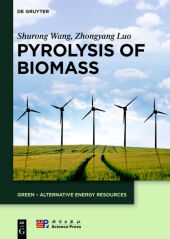 Neuerscheinungen 2016Stand: 2020-02-01 |
Schnellsuche
ISBN/Stichwort/Autor
|
Herderstraße 10
10625 Berlin
Tel.: 030 315 714 16
Fax 030 315 714 14
info@buchspektrum.de |

China Science Publishing & Med, Zhongyang Luo, Shurong Wang
(Beteiligte)
Pyrolysis of Biomass
Mitarbeit: China Science Publishing & Media Ltd.
2016. XII, 256 S. 115 b/w and 35 col. ill., 50 b/w tbl. 240 mm
Verlag/Jahr: DE GRUYTER 2016
ISBN: 3-11-037457-9 (3110374579)
Neue ISBN: 978-3-11-037457-5 (9783110374575)
Preis und Lieferzeit: Bitte klicken
With the development of societies fossil energy is no longer the only energy resource, and increasing attention had been paid to alternative energy. Biomass is considered to be one of the alternatives due to efficiency and low cost. This book presents biomass pyrolysis behavior for three main components: Cellulose, Hemicellulose and Lignin, and discusses the influence of mineral salts , zeolite catalysts and metal oxide on their pyrolysis.
Chapter 1 Biomass components and their characteristics
1.1 Biomass components
1.1.1 Ultimate and proximate analysis
1.1.2 Components composition
1.2 Cellulose
1.2.1 Structure characteristics of cellulose
1.2.2 Physico-chemical properties of cellulose
1.2.3 Cellulose model compounds and the isolation of cellulose
1.3 Hemicellulose
1.3.1 Structure characteristics of hemicellulose
1.3.2 Physico-chemical properties of hemicellulose
1.3.3 Hemicellulose model compounds and the isolation of hemicellulose
1.4 Lignin
1.4.1 Structure characteristics of lignin
1.4.2 Physico-chemical properties of lignin
1.4.3 Lignin model compounds and the isolation of lignin
1.5 Extractive
1.6 Mineral Salt
1.6.1 Compositions of mineral salts
1.6.2 Leaching of mineral salts
1.7 Moisture in raw biomass
Reference
Chapter 2 Pyrolysis of cellulose
2.1 Process of cellulose pyrolysis
2.1.1 Overview of cellulose pyrolysis
2.1.2 Pyrolysis of cellulose model compounds
2.2 Effects of different parameters on the pyrolysis behavior of cellulose
2.2.1 Effects of temperature
2.2.2 Effects of residence time
2.2.3 Effects of acid pretreatment
2.2.4 Effects of other parameters
2.3 Kinetic models for cellulose pyrolysis
2.3.1 Single step model
2.3.2 Two step model
2.3.3 Multi-step model
2.4 Active cellulose
2.4.1 The acquisition and characterization of active cellulose
2.4.2 Effects of different parameters on the characteristics of active cellulose
2.5 Mechanism of cellulose pyrolysis based on product formation
2.5.1 Formation mechanism of levoglucosan
2.5.2 Formation mechanism of 5-hydroxymethl furfural
2.5.3 Formation mechanism of glycolaldehyde and 1-hydroxy-2-propanone
2.5.4 Formation mechanism of small molecular gases
2.6 Application of computational chemistry in the study of mechanism of cellulose pyrolysis
2.6.1 Simulation of cellulose monomer pyrolysis
2.6.2 Simulation of cellobiose and cellotriose pyrolysis
2.6.3 Simulation of periodically structural cellulose pyrolysis
Reference
Attached list
Chapter 3 Pyrolysis of hemicellulose
3.1 Process of hemicellulose pyrolysis
3.1.1 Pyrolysis of monosaccharides
3.1.2 Pyrolysis of xylan and other glycan
3.1.3 Pyrolysis of isolated hemicelluloses
3.1.4 Comparison of the pyrolysis of xylan and hemicellulose monosaccharides
3.2 Effects of different parameters on the pyrolysis behavior of hemicellulose
3.2.1 Effect of temperature
3.2.2 Effect of residence time
3.2.3 Effects of other parameters
3.3 Mechanism of hemicelluloses pyrolysis
3.3.1 Kinetic models for hemicellulose pyrolysis
3.3.2 Mechanism of hemicellulose pyrolysis based on products formation
3.3.3 Mechanism of hemicellulose pyrolysis at the molecular level
Reference
Attached list
Chapter 4 Pyrolysis of lignin
4.1 Process of lignin pyrolysis
4.1.1 Introduction of lignin pyrolysis
4.1.2 Pyrolysis of lignin model compounds with typical functional groups
4.1.3 Pyrolysis of various lignin
4.2 Effects of different parameters on the pyrolysis behavior of lignin
4.2.1 Effect of temperature
4.2.2 Effect of residence time
4.2.3 Effects of other parameters
4.3 Mechanism of lignin pyrolysis
4.3.1 Kinetic models for lignin pyrolysis
4.3.2 Mechanism of lignin pyrolysis based on products formation
4.3.3 Mechanism of lignin pyrolysis at the molecular level
Reference
Attached list
Chapter 5 Interactions of biomass components during pyrolysis
5.1 Interaction of different biomass components
5.1.1 Interaction of cellulose and hemicellulose
5.1.1 Interaction of cellulose and lignin
5.1.1 Interaction of hemicellulose and lignin
5.2 Pyrolysis of three-component mixtures
5.2.1 Thermal weight loss behavior of different three-component mixtures
5.2.2 Products distribution from pyrolysis of different three-component mixtures
5.3 Pyrolysis of detergent fibers
5.3.1 Pyrolysis behavior of different detergent fibers
5.3.2 Products distribution from pyrolysis of different detergent fibers
5.4 Influ


